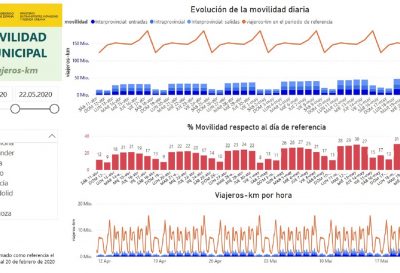
New Mobility Services in times of COVID-19: the MOMENTUM project’s approach
 Today, we speak with Javier Burrieza, transport- and mobility consultant at Nommon, a tech company based in Madrid, which provides big data and artificial intelligence solutions for the planning and management of transport systems. First and foremost, he supports Nommon as part of the project team to support the organisation’s role as the technical coordinator of the MOMENTUM project. Nommon leads the development of the work package reviewing the challenges and opportunities brought by emerging mobility solutions, as well as designing the case studies used for the demonstration of MOMENTUM techniques.
Today, we speak with Javier Burrieza, transport- and mobility consultant at Nommon, a tech company based in Madrid, which provides big data and artificial intelligence solutions for the planning and management of transport systems. First and foremost, he supports Nommon as part of the project team to support the organisation’s role as the technical coordinator of the MOMENTUM project. Nommon leads the development of the work package reviewing the challenges and opportunities brought by emerging mobility solutions, as well as designing the case studies used for the demonstration of MOMENTUM techniques.
Which aspects of the MOMENTUM project do you consider as most significant and why?
Transport planning and management needs accurate and up-to-date information about travel demand. From our experience, big data analytics is already improving decision-making processes in the transport sector, but emerging mobility solutions highlight this even more.
First, travel behaviour patterns are increasingly dynamic, so detailed data sources are essential to understand their role in the future of sustainable transport.
Second, new mobility operators collect rich data about the use and adoption of the systems they manage. The development of analysis techniques to exploit such data is very promising for the improvement of transport models and decision support tools, as the MOMENTUM project remarks.
In general, to what extent could mobility services improve public transport accessibility by complimenting it?
In the past, public transport planning was very much related to attending recurrent flows of commuters between dense residential areas and office or industrial zones. Nowadays travel demand spatial patterns are no longer as regular, nor as simple.
Metropolitan areas are spreading down to suburbs with low population density, also economic activities are scattered across the city. This splits the travel flows and increases the burden on public transport. In this regard, emerging services such as shared mobility can provide an on-demand solution for the so-called first-mile and last-mile.
Do you think that any of the emerging mobility solutions, which are tested in our cities, could be considered as established?
Currently, we are experiencing an unprecedented boost to new solutions, but I think transport history can teach us some lessons to understand what may happen. The transport sector has always been prone to innovation, and this entails both success and failure stories. For instance, 100 years ago airships were on the spotlight.
In general, it seems that vehicular concepts appear and disappear faster than broader concepts involving not only technology aspects. This may be the case of shared transport systems, since they can be seen as a direct translation of shared economy in transport solutions. Vehicles serving these systems are likely to change (e-scooters being the most recent example) but the concept behind shared mobility will remain.
COVID-19 could have such an impact. Did you observe a change in use of emerging mobility solutions during COVID-19?
 Yes. COVID-19 has a profound impact on transport supply and passenger choices. On the one hand, emerging mobility solutions are often offering individual mobility, satisfying the new user preferences towards options that prevent social contact. As a consequence, we can already see how bike sharing demand is recovering faster than mass transport demand after the lockdown.
Yes. COVID-19 has a profound impact on transport supply and passenger choices. On the one hand, emerging mobility solutions are often offering individual mobility, satisfying the new user preferences towards options that prevent social contact. As a consequence, we can already see how bike sharing demand is recovering faster than mass transport demand after the lockdown.
On the other hand, shared mobility vehicles are used by several individuals throughout the day, which implies a need for disinfection solutions similar to those already implemented by public transport operators.
Let’s be a little bit more specific, in what way will emerging mobility solutions have an influence on the traffic flows in post-lockdown times?
The challenge is to promote sustainable and active individual modes, namely cycling and walking, to avoid the adverse impacts of extensive private car use. Bike sharing and micro mobility are already playing an important role in this, but we have to be aware that not all citizens can use these systems and that the spatial coverage is often limited to the city centres. Car sharing and e-hailing can complete this picture by providing additional alternatives to private car use.
Let’s focus on the direct impact of COVID-19 on our MOMENTUM project. Does the virus have an influence on the case studies in the cities and if yes, which are they?
As we had the opportunity to discuss in our recent MOMENTUM Consortium Meeting, the four cities have seen dramatic changes in travel demand patterns in the last months due to the pandemic. Madrid may be a singular case among these, given it’s large size and the wide variety of emerging mobility solutions present in the city.
Overall travel demand plunged in mid-March down to 20% of the normal levels, and two months after this figure is still below 40%. Shared mobility operators closed down the services and have just started to operate again, so it will be interesting to monitor how their demand evolves in relation to other traditional modes.
In the current time frame, do you think that shared mobility services are already a viable substitute for private cars? Additionally do you expect a difference between pre- and post-COVID-19 times?
A high degree of service reliability is basically the essential condition to switch from a private car to an alternative form of mobility. Recent studies suggest that shared mobility will only impact car ownership if users perceive that the supply is reliable. MOMENTUM expects to analyse this aspect by providing new supply indicators suitable for assessing the reliability of these modes, to make this question easier to answer.
Let’s look towards the future, what are the most significant challenges in terms of (digital) infrastructure and political frameworks and why?
One of the lessons learnt over the first year of the MOMENTUM project is that the successful deployment of emerging mobility solutions is more dependent on governance and management innovations than on technology itself.
The technology is mostly available already. However, technology can also help to overcome the governance challenges. A good example is the integration of services into MaaS platforms. Users are understandably reluctant to accumulate mobile apps and multiple memberships to the several services available in each city.
MaaS platforms can solve this, if the sector embraces more collaborative approaches that facilitate data sharing and integrative strategies. Here, technology can boost trust among stakeholders, by ensuring the security of the information exchanges needed for these platforms to work.
Furthermore, the deployment of the new transport systems has not been free of controversy in many cities, where operators and decision-makers were depicted as agents with diverging interests. Cooperation between these various actors needs to be fostered and adapted to the circumstances of emerging mobility solutions.
Fortunately, there are already successful stories of close collaboration among transport planners and new operators to make the most of the opportunities brought by shared mobility and other emerging services. The recent report from Partnership for Urban Mobility and our project deliverable D2.1 provide good examples of this.
How can interested readers find your and NOMMON’s work and is there anything you would like to highlight?
 Our readers can explore our website to check our projects and activities, always devoted to an effective use of big data sources for improving the efficiency of transport systems. Another interesting project is the newly developed dashboard of the Spanish Ministry of Transport to monitor the mobility across the country during the COVID-19 crisis It highlights mobility information, which are providing to them based on the analysis of anonymised mobile phone records.
Our readers can explore our website to check our projects and activities, always devoted to an effective use of big data sources for improving the efficiency of transport systems. Another interesting project is the newly developed dashboard of the Spanish Ministry of Transport to monitor the mobility across the country during the COVID-19 crisis It highlights mobility information, which are providing to them based on the analysis of anonymised mobile phone records.
Precisely, COVID-19 has reminded us of the prominent role of mobility in our societies and the importance of maintaining a resilient transport system. MOMENTUM techniques and tools will help to implement emerging mobility solutions in a way that effectively contributes to the sustainability and resilience of urban mobility.


